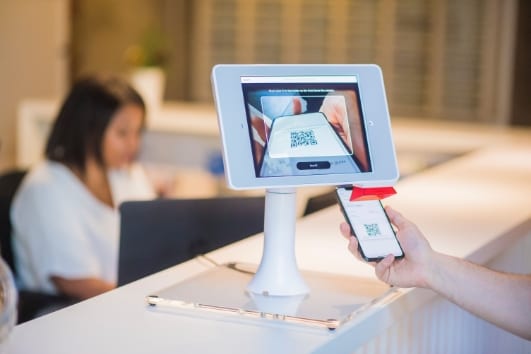
Make no mistake—the Internet of Things (IoT) is here to stay. In 2013, The McKinsey Global Institute listed IoT as one of 12 disruptive technologies that have the potential to transform life and business. Whether you’re just beginning to explore the options available to your office or you’re well on your way to a fully-integrated, smart workplace, it can be overwhelming to figure out where to put your attention and money. Do you need smart light bulbs or air quality sensors? Should you tag all your devices and equipment with QR codes to make it easier to file service requests?
For businesses, the Internet of Things makes a lot of promises: more efficient workspaces, better connection and collaboration, more data for companies to examine and use. We find that the real value comes when the data collected by IoT devices is integrated into a single software, creating high-level visibility of how your workplace functions. Let’s take a look at some of the Internet of Things business applications and devices that go above and beyond in the office:
Beacons and Sensors
Benefit: Accurate, real-time data about building usage and activity
These are the simplest and maybe the most ubiquitous Internet of Things technologies for businesses. Different companies use different names, but in most cases, they are small sensors that monitor foot traffic and activity in different rooms or at various workstations. Using these technologies, you’ll be able to learn which desks are used most often or if a conference room meant for 12 people never hosts more than six.
How to use it
The data gathered from beacons and motion sensors can help you make decisions about desk assignments (moving a team to a different floor for better collaboration, or removing assigned workstations completely). You probably already have an idea that certain workstations go unused or a certain room might be better suited as a collaboration space. If the beacon data backs up your assumptions, you can make a stronger case when proposing reassignments or other changes.
Beacons are also used in wayfinding tools and apps to help workers, locate a workstation, or choose a meeting room or collaboration space. According to Newmark Knight Frank, an average employee spends approximately 30 minutes a week trying to locate available meeting rooms. Depending on the size of your company, reducing this time can result in significant cost savings and boosts in productivity.
Sensors, similar to beacons, can track data like temperature and air quality (humidity, carbon dioxide levels, etc.), ambient light, ambient noise, and other factors. Over time, by combining the data you receive from your sensors or beacons, you can build a profile of the “ideal working environment” where your employees will be happy, comfortable, and productive.
Tracking activity and usage can also help you make decisions about your building systems, which brings us to…
Utilities
Benefit: Efficient energy usage and a lower carbon footprint
A smart thermostat that automatically adjusts the schedule of your HVAC system will likely start saving you money in utility costs almost immediately. It’s surprising how many HVAC systems are set to turn on hours before anyone shows up to work—smart thermostats make ongoing adjustments to the time and temperature for these systems to ensure they’re being used efficiently.
In the long-term, you’ll also save on maintenance and replacement costs. Since you’ll likely be using your HVAC system less, the equipment will last longer.
The same can be said for lighting. Smart bulbs can automatically adjust brightness and intensity to create a more comfortable work environment.
How to use it
Proactive maintenance reduces downtime: whether it’s a power outage or a malfunctioning heater that makes an office unbearable to work in, if you’re always reacting to maintenance issues, you’re losing money. Beyond using beacons or sensors and smart thermostats with your building systems, you can also track and monitor scheduled maintenance, inspections, and repairs to avoid glitches and outages.
Asset Management
Benefit: Faster turnaround on service requests
All your employees, along with your IT and janitorial staff, can use a single app to report everything from a damaged tablet to a leaky sink in the bathroom. Service requests can be filed and assessed quickly, and updates and progress reports communicated seamlessly. The collected data can help you make purchasing decisions.
How to use it
Start tagging every device, asset, and piece of equipment with a serial number or QR code. This makes reporting issues easy. It is also helpful when a manufacturer issues a safety recall for a certain chair model—you can quickly locate those chairs throughout your workspaces.
Well-Being
Benefit: Healthier, happier employees who are engaged and productive
Many offices face pushback from employees when trying to implement IoT technology because it feels like an invasion of privacy. One way to respond to that is to show how these devices and apps provide a direct benefit to the employee.
How to use it
Allow your employees to opt into an app that lets them set and track progress towards activity goals. Start a competition—which team can reach their goals first? Who can log the most steps each week or attend the most “walking meetings”?
There are sit/stand desks that connect to an app where each employee sets her preferences for the desk height. The app makes it easy for her to move to different workstations each day and have them automatically adjust to her preferences. In the meantime, you’re able to gather more data to make further improvements to her work environment.
The Internet of Things for Business Will Only Grow from Here
One of the Internet of Things’ great business benefits is its flexibility. There’s not one particular device or technology that defines IoT, so you can choose the technology that makes the most sense for your business and add to your system or adapt it over time. You can also run pilot tests with certain devices in small areas before implementing them throughout your entire portfolio.
One thing is sure, though: the data to be gained from the Internet of Things for business will become more and more invaluable and far reaching. With software that integrates with this technology, you’ll be able to make better, data-driven business decisions about everything from facilities management to allocations.


